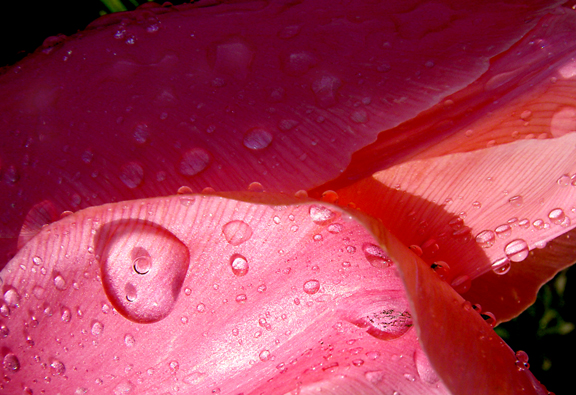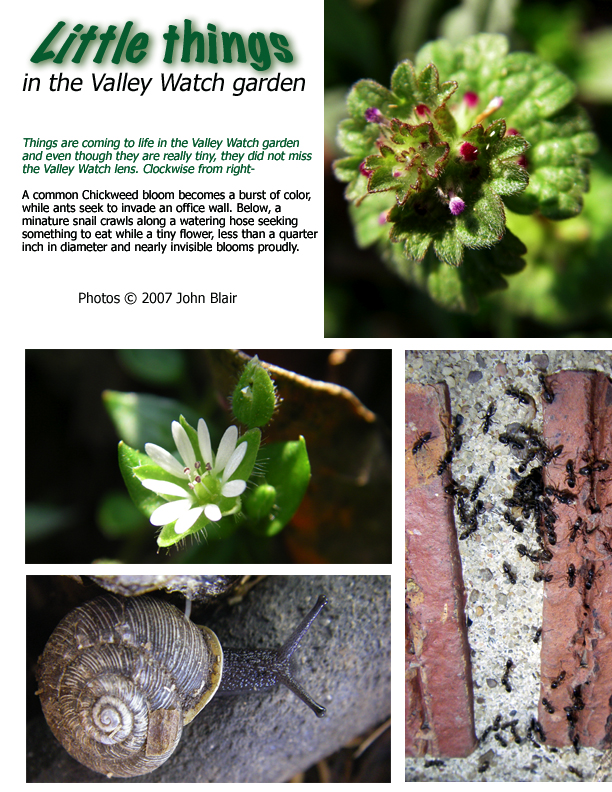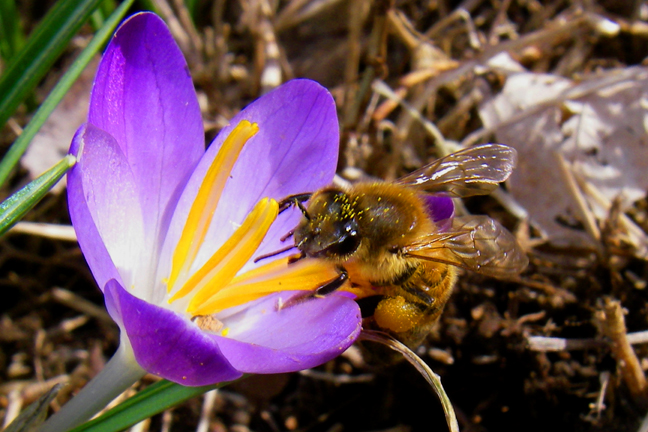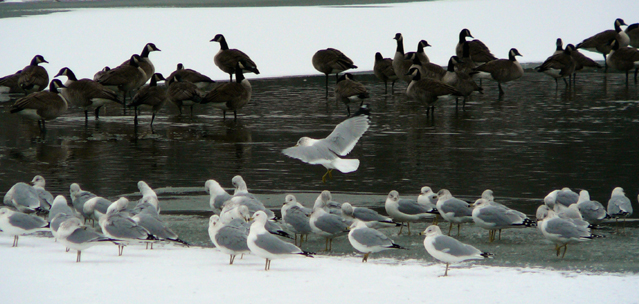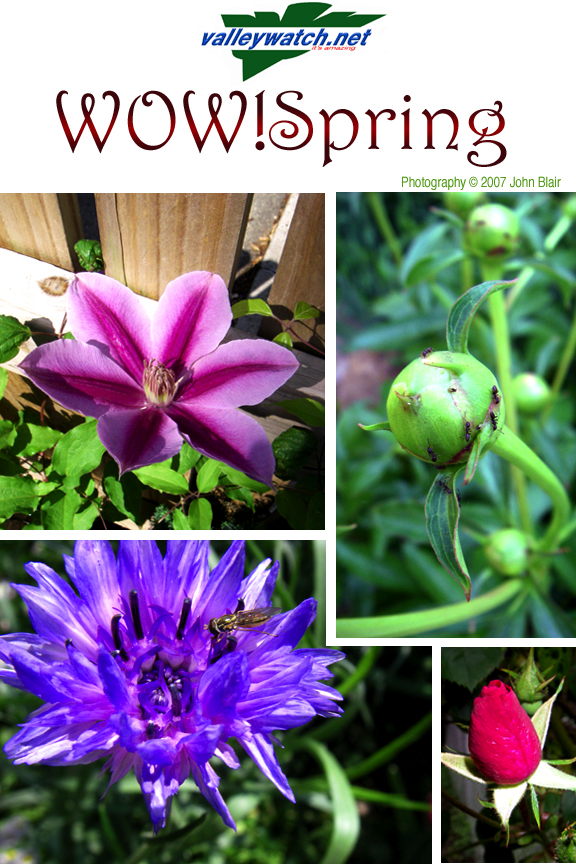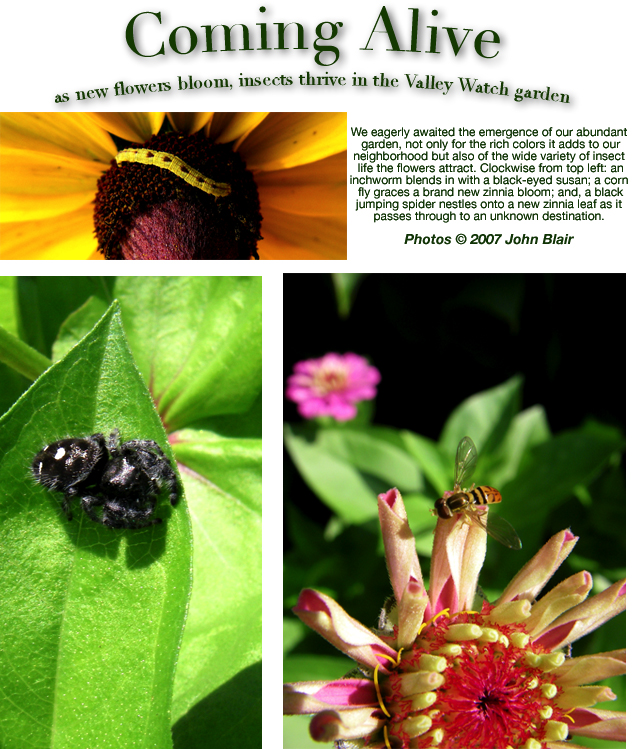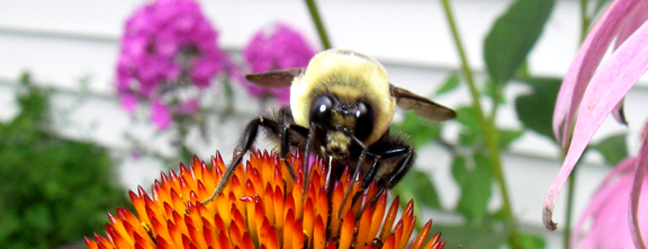Cool weather, warm weather-Tulips persevere
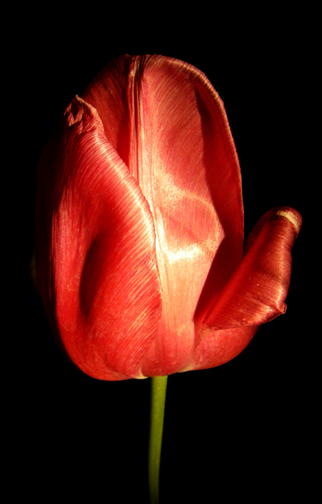 April 22, 2007 – Photo © 2007 John Blair. Tulips usually last about two weeks. Those in the Valley Watch garden has been an enigma this year with some in bloom almost a month.
April 22, 2007 – Photo © 2007 John Blair. Tulips usually last about two weeks. Those in the Valley Watch garden has been an enigma this year with some in bloom almost a month.
First, they emerged early, in January, as temperatures that month rose to record levels. Then a more typical February kept them from growing tall but they remained above ground. As March arrived, they began to bloom and looked great but a big drop in temperatures to sub-freezing levels for several days in early April caused them to stop in their tracks.
Now, they are hanging around, drying slowly, while small insects feast on their pedals. This picture was shot on the evening of Earth Day using a boat style spotlight for illumination.
Tulips are still trying to welcome spring
April 17, 2007 – Photo © 2007 John Blair. Tulips in the Valley Watch garden have held on through warm and cold weather to remain pretty in the setting sun.
These tulips survived the deep freeze, many blooms did not but Spring is still here.
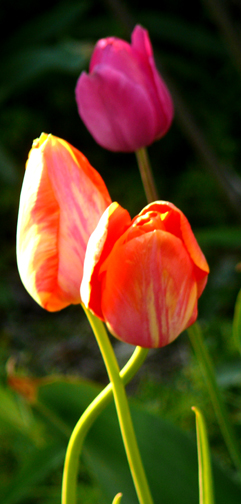 April 9, 2007 – Photo © 2007 John Blair. These tulips in the Valley Watch garden survived several freezing nights in the tri-state. Other blooms simply shriveled and died before they experienced their full glory. But temperatures are on the rebound and soon, new flowers will take their place as the cold snap diminishes and normal temperatures return.
April 9, 2007 – Photo © 2007 John Blair. These tulips in the Valley Watch garden survived several freezing nights in the tri-state. Other blooms simply shriveled and died before they experienced their full glory. But temperatures are on the rebound and soon, new flowers will take their place as the cold snap diminishes and normal temperatures return.
Blooming plants about to receive cold shock
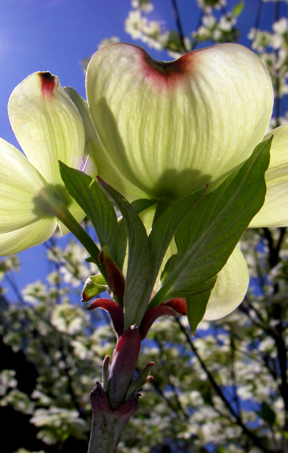 April 3, 2007 – Photo © 2007 John Blair. Blooming plants like this dogwood tree in Evansville may be short lived as a serious cold front is approaching that is predicted to plunge nighttime temperatures into the mid twenties by Good Friday.
April 3, 2007 – Photo © 2007 John Blair. Blooming plants like this dogwood tree in Evansville may be short lived as a serious cold front is approaching that is predicted to plunge nighttime temperatures into the mid twenties by Good Friday.
Dogwoods, Bluebells spring forth
March 27, 2007 – Dogwood blooms (L) and Bluebells are coming on strong as Spring emerges with 80 degree weather in the Valley Watch garden. Photos © 2007 John Blair
Spring arrives bringing color to our lives
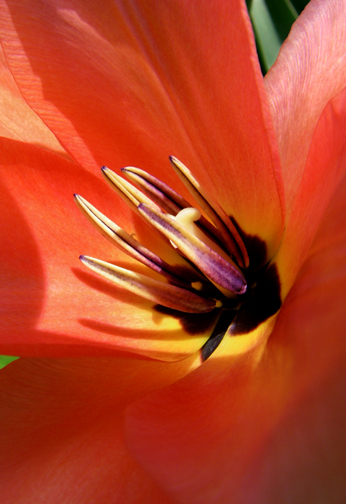 March 25, 2007 -Photo © 2007 John Blair. Pears, tulips, cherries and nearly everything else has sprung to life this week. This is the first tulip to bloom in the Valley Watch garden. We hope that this year will bring more exciting photos of nature both up close and at a distance. Please check this site often for new photos.
March 25, 2007 -Photo © 2007 John Blair. Pears, tulips, cherries and nearly everything else has sprung to life this week. This is the first tulip to bloom in the Valley Watch garden. We hope that this year will bring more exciting photos of nature both up close and at a distance. Please check this site often for new photos.
March 15, 2007
Still two weeks away but Spring has arrived
March 8, 2007 – Spring does not officially begin until March 21 when the Sun crosses the equator but the balmy weather of late has caused numerous buds to start opening on trees in the region. This one is a Bradford Pear bud. Photo© 2007 John Blair
Bees play a huge role in our continued ecological balance
March 2, 2007 – Photo © 2007 John Blair. Bees and other insects are fundamental to our ecological balance. They provide the vehicle for pollination of most plants as well as providing a variety of useful products like honey and beeswax. This one was seen doing its thing on one of the blooming crocus at the Valley Watch office. For more up close nature photography click on the link below
Go to Nature Photo Album
They’re back. Bees, crocus are sure indicators of an early spring
February 27, 2007-Photo© 2007 John Blair. This honey bee could wait no longer for spring to arrive as it makes its rounds gathering pollen from the only flowers around, early blooming crocus. Spring is not due to arrive until March 21 but tell that to this excited Apis.
Geese & Gulls, unlike humans peacefully co-exist
February 1, 2007 – Photo © 2007 John Blair. Seagulls and Canada Geese shared a frozen section of the USI Lake as the region experienced its first snowfall of the winter. It waited until February, but winter has finally gripped the region with predicted temps falling to near zero for Monday night.
Ducks and geese just chillin out
January 31, 2007 – Photo © 2007 John Blair. Ducks and geese throughout the tri-state are keeping cool these days as ice has formed on most ponds and lakes. These ducks have huddled together on the ice on Garvin Park Lake.
Stormy weather brings needed rain
May 4, 2007 – Stormy weather brought needed rain to the tri-state the last few days. this sunburst provided a pretty back drop as an airplane headed southwest and birds migrated north reflecting warmer air that was due to encompass the region over the next few days. Photo © 2007 John Blair
Green Bee checks out our garden
June 8, 2007 – Photo © 2007 John Blair. Metallic green bees are known officially as Agapostemon Splendins. Agapostemon is of green appearance (head-thorax always, sometimes also abdomen in some females). The female apex shows the typical vertical slot or furrow of Halictinae. They resemble members of the tribe Augochlorini, which are typically metallic in appearance.
Also, this week we have seen a return of at least one species of honey bee which, like the green one above, really like the Bachelor Buttons that were among the first flowers in the Valley Watch garden to bloom.
Bumble bees like hollyhocks, pollen 
June 1, 2007 – Photo © 2007 John Blair. A few honey bees have shown up in the garden since they mysteriously disappeared in much of the midwest in April but the lack of honey bees just make the day for this bumble bee as it gathers pollen from one of the numerous hollyhocks in the Valley Watch garden.
Other nature pictures from 2007 are available by clicking the link below.
Go to 07 Nature Photo Album
Japanese Beetles are pretty garden pests.
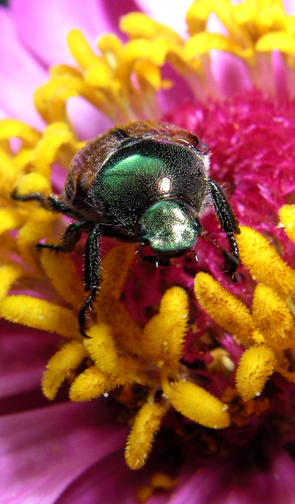 June 17, 2007-Photo © 2007 John Blair. Japanese beetles invaded the garden this week, eating their way through everything green or supple. But like most of nature, they do present as things of unique beauty.
June 17, 2007-Photo © 2007 John Blair. Japanese beetles invaded the garden this week, eating their way through everything green or supple. But like most of nature, they do present as things of unique beauty.
At Valley Watch, we do not use insecticides so we diligently pick them off flowers and greenery. Then we throw them into their own little bucket half full of water from which they never escape.
We considered using one of the pheromone based traps but we’ve repeatedly been warned that those things only attract the little pests
Face to face with nature
July 14, 2007 – Photo © 2007 John Blair. There are a huge number of bee species. Big, small, in between. Yellow, black, green and gold. This one looks like a wide body jet airplane.
Bees are one of nature’s most valuable assets. They pollenate plants and give us honey. This year they have been kind of random.
In early February, we saw a honey bee working on a crocus that had bloomed in January. Next were the reports of complete hives just disappearing in the spring. In early June the honeybees seemed to return to the garden but have now disappeared again, leaving more pollen for larger bees like this one.
The fate of the honey bee seems to hang in the balance at this time and their future is uncertain. What is causing their disappearing act is unknown and has scientists baffled for the moment.
Celebrate the demise of winter
 December 21, 2007-by John Blair. Winter came in with a whimper. Temps are supposed to be in the upper 50s today, the first day of a season known for snow and basketball. Well, it is a good thing that IU has a decent team this year or winter might be a bomb. This morning I found this lilac bush ready to burst forth in its best spring splendor. Usually, the lilacs do not bloom until early April.
December 21, 2007-by John Blair. Winter came in with a whimper. Temps are supposed to be in the upper 50s today, the first day of a season known for snow and basketball. Well, it is a good thing that IU has a decent team this year or winter might be a bomb. This morning I found this lilac bush ready to burst forth in its best spring splendor. Usually, the lilacs do not bloom until early April.
Isn’t it ironic that our Indiana Department of Environmental Management held a bogus public hearing last night on Duke Energy’s proposal to build yet another coal plant in SW Indiana which already has more coal capacity than anywhere else in the world.
It is as if they have never heard of global warming and climate change as they are seeking to grant Duke permission for another 4 million tons of carbon dioxide to our atmosphere without even blinking a skeptical eye.
And lots of supporters, hoping to cash in on the plant in some way, showed up to pledge the lives of their children to more coal.
Of course they are blind to the ravages of global warming and their philosophy of selfish interest commands they ignore the warnings and act as if they are the center of the universe.
They seek their new very expensive toy, estimated to cost upwards of $3 billion because they think that coal is their salvation.
But they are miserably wrong.
Coal, wherever it is mined or consumed is the bane of their economic future. Just look around at the communities that have chosen the coal path in Indiana and Kentucky. None are prosperous although billions have been invested nearby.
Coal brings prosperity only for its owners, leaving a legacy of ill health and filthy communities everywhere it lies, above or below the ground.
But, global warming shows that coal is not simply a local issue. Indeed, it is the central cause of climate change. And although it is sometimes subtle, climate change is upon us.
Just ask the lilacs in this Evansville, Indiana garden.
River gulls appear in November, stay if its warm
 November 21, 2007-Photo © 2007 John Blair. Flocks of migrant gulls pass through Evansville every fall. Some years they are aound for days, at other times they stay for weeks.
November 21, 2007-Photo © 2007 John Blair. Flocks of migrant gulls pass through Evansville every fall. Some years they are aound for days, at other times they stay for weeks.
Warm autumn yields muted colors
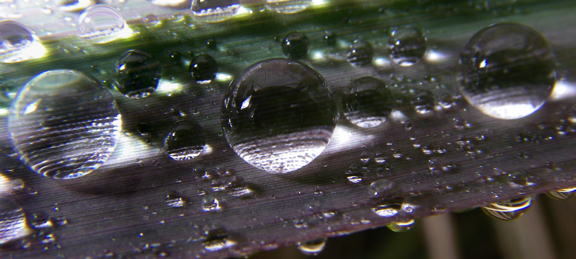 November 13, 2007-Intermittent rain and unseasonably warm temperatures have kept leaves and grasses green with winter just a few weeks away. This photo, © 2007 John Blair shows rain drops collected on Pompous Grass at the Valley Watch office.
November 13, 2007-Intermittent rain and unseasonably warm temperatures have kept leaves and grasses green with winter just a few weeks away. This photo, © 2007 John Blair shows rain drops collected on Pompous Grass at the Valley Watch office.
Snap Dragons live on despite cold
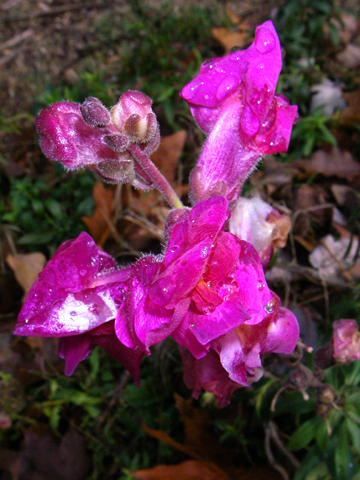 December 11, 2007-One clump of Snap Dragons continue to bloom in the Valley Watch garden even though temps have plunged into the low twenties several times in the last couple of weeks. Photo ©2007 John Blair
December 11, 2007-One clump of Snap Dragons continue to bloom in the Valley Watch garden even though temps have plunged into the low twenties several times in the last couple of weeks. Photo ©2007 John Blair
Perhaps it is due to the fact that the blooms are relatively close to the ground or maybe they are just extremely hardy plants, but they are the last of the flowers from this year to survive, even out pacing the second blooming of some Irises that came on in late November.
|
|

